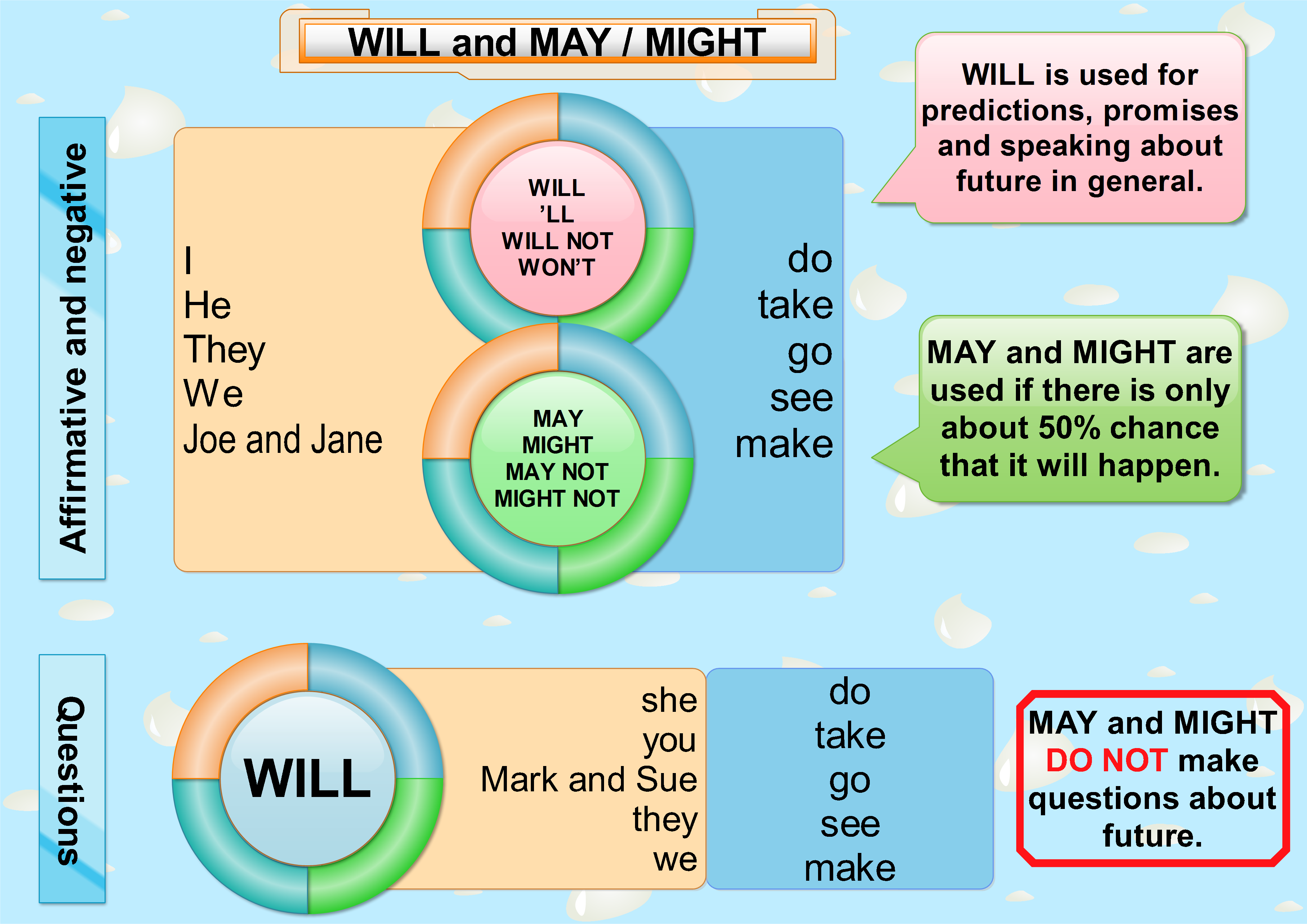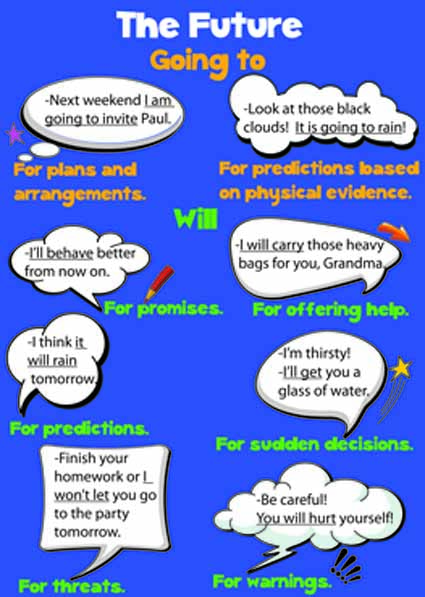MAY,MIGHT,AND WILL FOR FUTURE POSSIBILITY

May and Might
1. To express (future) possibility
There is a chance that something is true or that there is a
possibility of something happening.
2. To give permission
You may leave the table once you have finished
your meal.
You may take only one brochure.
If you have finished the exam, you may leave the
room.
May not can be used to NOT give permission or to
prohibit someone from doing something.
3. To ask for permission
Note: Can is used more frequently than May in
spoken English though May sounds more polite.
May I sit next to you?
May I borrow your pen?
4. May: to talk about typical occurrences
May is used in academic (or scientific) language to
refer to things that typically happen in certain situations.
Drivers may feel tired if they do not take a break
every 2 hours.
5. Speculate about past actions (May + have + past
participle)
She is late. I think she may have missed her
plane.
It may have already been broken before you bought
it.
What was that noise? It may have been a dog
outside our window.
6. To express wishes
May you both live a long and happy life together.
May the New Year bring you love and happiness.
May all your wishes come true.

Verbos Modales: MAY – MIGHT
Otro de los verbos
modales que se utilizan frecuentemente en el idioma inglés
es MAY, un verbo que es empleado para hacer referencia a una situación
hipotética, es decir que puede ser posible, por ejemplo:
They may forgive me.
|
Ellos pueden perdonarme.
|
She may decide to travel to Spain.
|
Ella puede decidir viajar a España.
|
He may accept your request.
|
Él puede aceptar tu pedido.
|
Observe en los ejemplos superiores que cuando utilizamos la palabra “puede” nos referimos a una probabilidad y no a la capacidad de hacer algo, ya que en tal caso utilizaríamos
el verbo modal CAN
El verbo modal MAY se encuentra relacionado
estrechamente con MIGHT dado que ambos tienen el mismo uso y
significado, aunque MAY indica un grado mayor de certeza, por
ejemplo:
ejemplo:
She may forget the problems.
|
Ella puede olvidar los problemas.
|
She might forget the problems.
|
Ella podría olvidar los problemas.
|
You may pay the bills.
|
Tú puedes pagar las cuentas.
|
You might pay the bills.
|
Tú podrías pagar las cuentas.
|
Para expresar una posibilidad en el futuro, solamente deberemos colocarle a la oración el momento en que se realizará la acción, por ejemplo:
She may help me tomorrow.
|
Ella podrá ayudarme mañana.
|
They might visit the hospital this afternoon.
|
Ellos podrían visitar el hospital esta tarde.
|
Tanto MAY como MIGHT se utilizan para solicitar algo de manera formal y educada, siendo el último un término de mayor cortesía, por ejemplo:
May I use your telephone please?
|
Puedo usar su teléfono por favor?
|
Might I use your telephone please?
|
Podría usar su teléfono por favor?
|
Para construir la forma negativa de ambos verbos modales lo haremos de la siguiente manera:
She may not apologize her friend.
|
Ella no puede disculpar a su amiga.
|
He might not find a solution to his problem.
|
Él no podría encontrar una solución a su problema.
|

Will y Going To – tiempos verbales para hablar del futuro en
inglés
¿Sabes usar bien will y going to?
Muchas veces, mis estudiantes han aprendido que en
inglés, el futuro se hace con “will.”
Así de sencillo.
Aunque es verdad que “will” es una forma de hablar del
futuro, en realidad tenemos varios futuros. Hoy hablaremos de dos, que son muy
diferentes.
El otro futuro, algo más largo, es GOING TO + infinitivo.
Es muy importante saber la diferencia entre will y going to,
y probablemente no es lo que
piensas.
piensas.
Así pues, aquí tienes unos ejemplos…
Cómo usar will y going to en inglés
Este punto es muy importante:
Going to se usa para hablar de intenciones y planes para el
futuro.
Así diríamos:
I’m going to make chicken for dinner.
She’s going to visit her grandmother tomorrow.
I’m going to look for a job as soon as I finish university.
Las tres frases hablan de un plan. (Fíjate también que es
necesario usar una forma del
verbo to be (am, iso are) antes.
verbo to be (am, iso are) antes.
De la misma manera, usamos going to + infinitivo para
preguntar sobre planes para el futuro:
What are you going to do this weekend?
What film are you going to see at the cinema?
What are you going to buy at the supermarket?
Las negaciones en esta forma usan not going to +
infinitivo para hablar de la intención de no hacer algo.
I’m not going to buy anything at the supermarket.
She’s not going to come to his birthday party.
They’re not going to listen to you.
Who do you think will win the football match? (Previsión
de futuro con will.) Cristiano Ronaldo, foto de jan solo en flickr.
Cómo usar will para decisiones espontáneas
Will, en cambio, se usa para hablar de decisiones
espontáneas y en condicionales:
The phone’s ringing. I’ll get it! (No habías planeado
coger el teléfono, lo has decidido ahora, cuando empezó a sonar.)
If I go to the supermarket, I’ll buy some tuna. (No
estoy seguro que voy al supermercado.)
What will you do if you fail your test? (No piensas
suspender.)
Para hacer la negación, usamos won’t. Sirve
también para negarte a hacer algo.
I won’t speak to him after what he said last time.
If it rains, I won’t go out.
She won’t like the idea of spending so much money on the
repairs.
Will para previsiones del futuro
Will también se usa para previsiones (cosas
que pensamos que van a pasar).
Do you think it will rain tomorrow?
I imagine I’ll see him later. He’ll probably be there.
Who do you think will win the football match?
I think the Boston Celtics will win the NBA finals.
Es muy importante usar bien los tiempos verbales. No nos basta usar
solo el presente. Cuesta aprenderlos bien, pero vale la pena.

When to use GOING TO
The structure BE GOING TO is normally used to
indicate the future but with some type of connection to the present. We use it
in the following situations:
1. When we have already decided or we INTEND to do something
in the future. (Prior Plan)
The decision has been made before the moment of speaking.
2. When there are definite signs that something is going to
happen. (Evidence)
Something
is likely to happen based on the evidence or experience you have.
I think
it is going to rain - I just felt a drop.
I don't
feel well. I think I'm going to throw up. (throw up = vomit)
3. When
something is about to happen:
Get back!
The bomb is going to explode.

When to use
WILL
In other
cases, where there is no implicit or explicit connection to the present,
use WILL:
1. For things that we decide to do now. (Rapid Decisions)
This is
when you make a decision at that moment, in a spontaneous way.
I'll buy
one for you too.
I think I'll
try one of those. (I just decided this right now)
2. When we think or believe something about the future. (Prediction)
My team
will not win the league this season.
I think it
will rain later so take an umbrella with you.
3. To make
an offer, a promise or a threat.
I'll give
you a discount if you buy it right now.
I promise I
will behave next time.
I'll take
you to the movies if you'd like.
4. You use WON'T when someone refuses to do something.
I told him
to take out the trash but he won't do it.
My
kids won't listen to anything I say.
My
car won't start.

Future
Predictions
As you can
see, both Will and Going to can be used for making future
predictions without having a real difference in meaning.
The weather
report says it will rain tomorrow. (Correct)
The weather
report says it is going to rain tomorrow. (Correct)
Compare Will vs. Going To
If someone
asks: "Are you busy this evening?"
If I
respond: "Yes, I'm going to the movies." I use going to because
it is a plan I made earlier (before I was asked the question). - In this case
we cannot use Will.
Both will and going
to are possible in this situation because we are predicting what will
happen (since we haven't made any plans).













